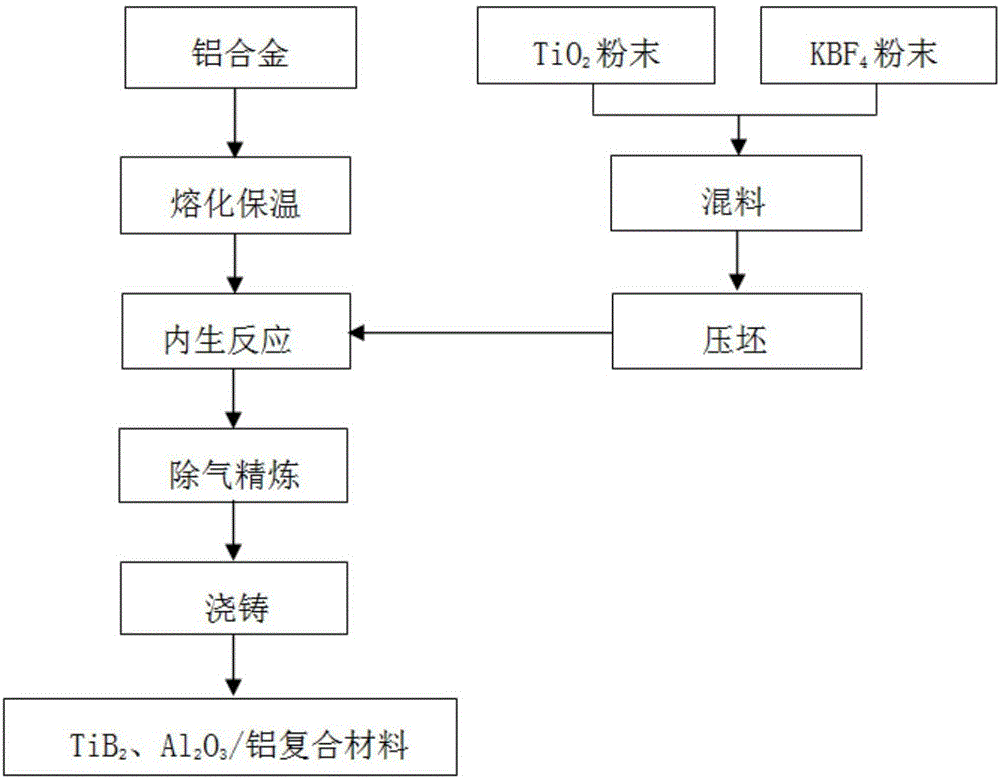Preparation method of endogenous double-phase particle enhanced aluminum-based composite material
A technology for particle-reinforced aluminum and composite materials, applied in the field of metal matrix composite materials, can solve the problems of difficulty in the reaction between the reinforcement particles and the interface, poor compatibility between the reinforcement particles and the matrix, and restrictions on industrial promotion.
- Summary
- Abstract
- Description
- Claims
- Application Information
AI Technical Summary
Problems solved by technology
Method used
Image
Examples
Embodiment 1
[0060] (1) Preparation of mixed powder: weigh 30g of TiO with a particle size of 100-150 mesh 2 Powder and 94.59g KBF with a particle size of 100-150 mesh 4 Powder (the molar ratio of Ti and B is 1:2, the mixed powder accounts for 4.91% of the weight of aluminum alloy, regardless of loss), mixed in a mixer for 2 hours, and then dried at 200 ° C for 1 hour, A mixed powder is obtained.
[0061] (2) Mixed powder compact: the mixed powder obtained in step (1) is pressed with a press under a pressure of 100 MPa to obtain a mixed powder compact.
[0062] (3) Melting and heat preservation of aluminum alloy: Weigh 2537g of ZL101 aluminum alloy, and then heat the weighed aluminum alloy to 850°C to melt and heat it for 10 minutes.
[0063] (4)TiB 2 and Al 2 o 3 In-situ formation of dual-phase ceramic particles: Add the mixed powder blank obtained in step (2) to the aluminum alloy melt obtained in step (3) to react with the internal particles. Stir for 60 minutes until the endogeno...
Embodiment 2
[0067] (1) Preparation of mixed powder: weigh 90g of TiO with a particle size of 160-230 mesh 2 Powder and 283.7g KBF with a particle size of 160-230 mesh 4 Powder (the molar ratio of Ti to B is 1:2, the mixed powder accounts for 9.89% of the weight of the aluminum alloy weighed), mixed in a mixer for 2.5 hours, and then dried at a temperature of 240°C for 2 hours to obtain a mixed powder.
[0068] (2) Mixed powder compact: the mixed powder obtained in step (1) is pressed with a press under a pressure of 250 MPa to obtain a mixed powder compact.
[0069] (3) Melting and heat preservation of aluminum alloy: Weigh 3778.6g of ZL201 aluminum alloy, and then heat the weighed aluminum alloy to 880°C to melt and heat it for 30 minutes.
[0070] (4)TiB 2 and Al 2 o 3 In-situ formation of dual-phase ceramic particles: Add the mixed powder blank obtained in step (2) to the aluminum alloy melt obtained in step (3) to react with the inner particles. Stir for 70 minutes until the endo...
Embodiment 3
[0074] (1) Preparation of mixed powder: weigh 200g of TiO with a particle size of 230-300 mesh2 Powder and 630.6g particle size 230~300 mesh KBF 4 Powder (the molar ratio of Ti and B is 1:2, the mixed powder accounts for 35.9% of the weight of the aluminum alloy weighed), mixed in a mixer for 3 hours, and then dried at a temperature of 270°C for 3 hours to obtain a mixed powder.
[0075] (2) Mixed powder compact: the mixed powder obtained in step (1) is pressed with a press under a pressure of 350 MPa to obtain a mixed powder compact.
[0076] (3) Melting and heat preservation of aluminum alloy: Weigh 2432.6g of ZL111 aluminum alloy, and then heat the weighed aluminum alloy to 900°C to melt and hold it for 40 minutes.
[0077] (4)TiB 2 and Al 2 o 3 In-situ formation of dual-phase ceramic particles: Add the mixed powder blank obtained in step (2) to the aluminum alloy melt obtained in step (3) to react with the inner particles. Stir for 80 minutes until the endogenous react...
PUM
| Property | Measurement | Unit |
|---|---|---|
| particle size | aaaaa | aaaaa |
| particle size | aaaaa | aaaaa |
| size | aaaaa | aaaaa |
Abstract
Description
Claims
Application Information
 Login to View More
Login to View More - R&D
- Intellectual Property
- Life Sciences
- Materials
- Tech Scout
- Unparalleled Data Quality
- Higher Quality Content
- 60% Fewer Hallucinations
Browse by: Latest US Patents, China's latest patents, Technical Efficacy Thesaurus, Application Domain, Technology Topic, Popular Technical Reports.
© 2025 PatSnap. All rights reserved.Legal|Privacy policy|Modern Slavery Act Transparency Statement|Sitemap|About US| Contact US: help@patsnap.com



